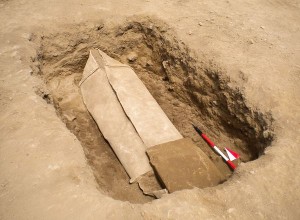 The word on whether this one was folded over into a burrito as well, but it was discovered just meters away from the 800-pound lead sarcophagus unearthed in 2009.
The word on whether this one was folded over into a burrito as well, but it was discovered just meters away from the 800-pound lead sarcophagus unearthed in 2009.
According to the Gabii Project blog, the human remains inside the 2009 coffin were roughly dated to the 3rd century A.D. According to this most recent article, both the 2009 coffin and its newly discovered double date to the 1st or 2nd century A.D.
Whatever the date, finding just one lead coffin is rare; two is downright uncanny. Lead was extremely expensive and as such not a commonly used burial medium.
According the site director, archaeologist Anna Gallone, the two sarcophagi are examples of a unique local burial custom found in Gabii.
“The massive use of lead in the tombs is unique, it has never been seen before in central Italy,” Gallone told Adnkronos International (AKI).
The same archaeological team discovered both coffins. Directed by Nicola Terrenato of the University of Michigan, the Gabii Project has been ongoing since 2007, starting with an extensive geophysical survey of the 40 hectares of Gabii’s urban center which, along with a magnetometry survey, took the first two years. Those surveys uncovered the urban grid of the city within the old walls. The team used the city grid to figure out where they should be digging. Time well spent, obviously.
Eleven miles east of Rome, the city-state of Gabii was prominent in the first millennium B.C., a rival of early Rome under the kings, but an official ally of the Republic by 493 B.C. It was on the decline in the 1st century B.C., in part thanks to the overquarrying of a valuable stone that was underneath the city, but it was still inhabited and getting infrastructure built during the reign of Hadrian (117–138 A.D.). References to the town disappear from the ancient sources after the 3rd century.
Although there was some later building in the area — a medieval tower was built on the site of Gabii’s acropolis — much of the land was left undeveloped, make Gabii an excellent source of archaeological information about first millennium B.C. life in the Latin states.